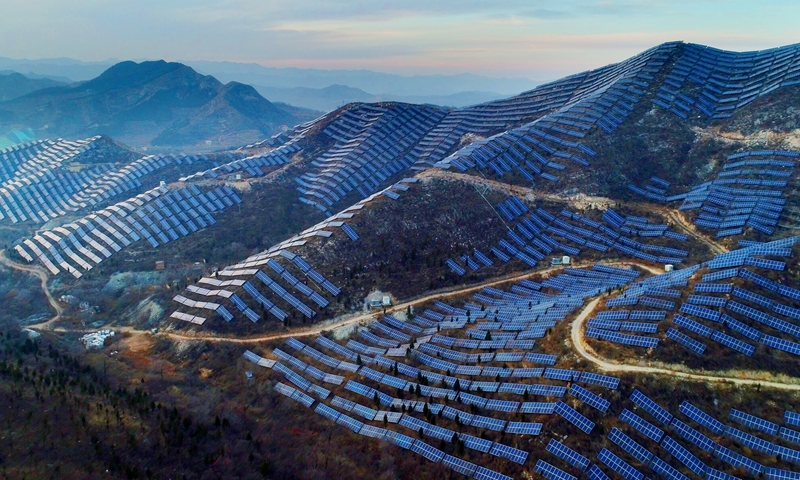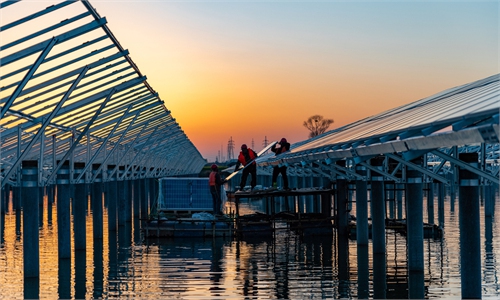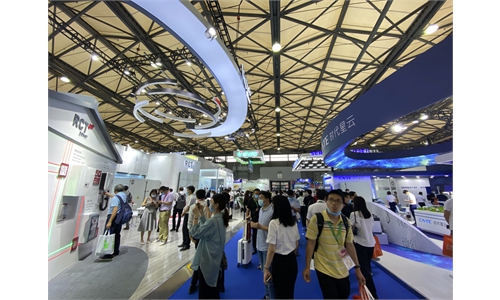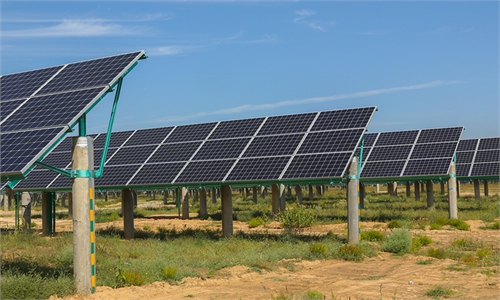China will exhaust legal provisions for appeals to the WTO on US solar tariffs: analyst
Photovoltaic tariffs are hurting US' own industry with fewer jobs, less investment and higher prices: report

Solar panels on barren hills of Mount Taihang in Handan, North China's Hebei Province Photo: VCG
China appealed on Monday a WTO panel report on US' tariffs imposed on Chinese solar panels during the Trump administration. The panel rejected China's claims earlier this month.
Analysts said that China will exhaust the legal provisions for appeal although it will probably still be dismissed.
"China's appeal is not just made for this case but for the future. Countries that initiate trade protection measures against China need to bear higher costs," Mei Xinyu, a research fellow at the Chinese Academy of International Trade and Economic Cooperation of China's Ministry of Commerce, told the Global Times.
China has notified the WTO's Dispute Settlement Body of its decision to appeal the panel report in the case brought by China in "United States — Safeguard Measure on Imports of Crystalline Silicon Photovoltaic Products" (DS562), according to a statement by the WTO published on Monday.
A WTO panel issued a report regarding the US safeguards on imported photovoltaic cells from China on September 2, rejecting all of China's claims, saying that China did not establish that the US' safeguard measure on certain crystalline silicon photovoltaic products failed to comply with the requirement in relevant articles.
"Overall, the ruling will have little impact on China's photovoltaic industry. Photovoltaic is a new industry. China's solar industry started later than the US but its development and technological innovation are much faster than those of the US and Europe. The quality improvement is very fast, so it can offset the effect of tariff protection," said Mei.
The case dates back to April 2017 when US manufacturers filed a suit to the US Commerce Department.
In August 2018 China requested consultations with the US concerning the definitive safeguard measure imposed by the US on imports of certain crystalline silicon photovoltaic products.
According to the Office of US Trade Representatives, the US safeguard measure imposes a tariff quota on imports of cells and modules over a four-year period currently set to expire on February 6, 2022. US producers have asked the US International Trade Commission to review a safeguard extension. That review is ongoing.
"In short, the US is pinning its hopes on tariff protection. Its strong point is its ability to litigate rather than industrial progress and competitiveness. China should continue to focus its core competitiveness on production and innovation. Let the US focus on competitiveness on litigation," Mei said, noting that by protecting its own industry with tariffs, the US has raised the cost of photovoltaic cells domestically.
According to the Solar Energy Industries Association (SEIA), the tariffs have caused great harm to the US solar industry and the broader economy. As a result, the country lost a total of 62,000 jobs from 2017 to 2021, missed 10.5 gigawatts of solar deployment enough to power 1.8 million homes and avoid 26 million metric tons of carbon dioxide emissions. The US also experienced $19 billion in lost investment and prices 43 to 57 percent higher than the global average.
Supply chain constraints, the recent Withhold Release Order from the US government on solar imports, and the potential for expanded and extended tariffs from recent trade petitions pose downside risks to near-term growth, according to the US Solar Market Insight report by the SEIA released on September 14.
"This is a critical moment for our climate future but price increases, supply chain disruptions and a series of trade risks are threatening our ability to decarbonize the electric grid," said Abigail Ross Hopper, SEIA president and CEO.
The US keeps increasing tariffs on imported photovoltaic products in order to suppress overseas manufacturers and protect the development of its local photovoltaic industry, analysts said.
However, from the perspective of Chinese photovoltaic companies, the impact of the US crackdown has been greatly weakened by the deepening globalization of their businesses.
Several Chinese photovoltaic companies said that the US has imposed the highest tariffs on Chinese solar products while duties on products from other parts of the world are lower. As Chinese companies continue to go global and set up factories abroad, they are well placed to cope with increasingly stringent tariffs by the US, China Energy News reported.
According to the Report of the China Photovoltaic Industry Association, by 2020, Chinese photovoltaic enterprises had an overseas production capacity of more than 53 gigawatts.



